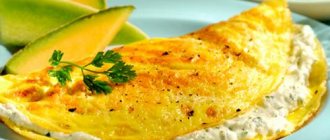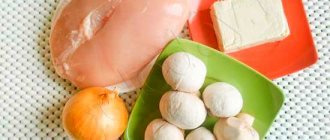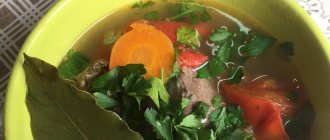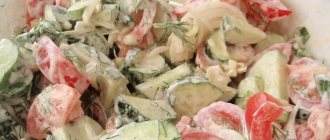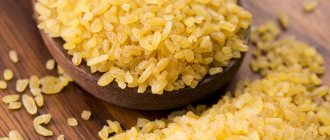Canned
| Product | Squirrels | Fats | Carbohydrates | Kcal per 100 g. |
| bamboo | 1.72 | 0.4 | 3.22 | 19 |
| basil | 3.15 | 0.64 | 1.05 | 23 |
| parsley | 2.5 | 0.5 | 6.3 | 40 |
| dill | 2.5 | 0.5 | 6.3 | 40 |
| spinach | 2.11 | 0.37 | 2.92 | 19 |
| sorrel | 1.83 | 0.64 | 0.33 | 20 |
The benefits and dangers of parsley
Parsley
champion in vitamin C content. A small bunch of parsley provides the body's daily need for this essential vitamin.
In addition, parsley contains carotene and iron.
Parsley also has a diuretic effect. It is also capable of dissolving sand and stones in the bladder. Therefore, it is recommended as a diuretic and carminative.
Parsley has a stimulating effect on the muscles of the uterus, so pregnant women do not need to eat it in large quantities. It can cause a miscarriage.
Leaves
| Product | Squirrels | Fats | Carbohydrates | Kcal per 100 g. |
| aloe | 0 | 0 | 6 | 20 |
| amaranth | 2.46 | 0.33 | 4.02 | 23 |
| bamboo | 5 | 10 | 50 | 400 |
| grape | 5.6 | 2.12 | 6.31 | 93 |
| cherries | 0.1 | 0 | 0.1 | 1 |
| and you | 6.1 | 1.6 | 20.7 | 122 |
| curry | 16.84 | 8.29 | 17.46 | 202.86 |
| currants | 0.1 | 0 | 0.1 | 1 |
| horseradish | 9.4 | 1.4 | 6.28 | 64 |
| chrysanthemums | 3.36 | 0.56 | 0.01 | 24 |
| rosehip | 0.3 | 0 | 12.1 | 49.9 |
| eucalyptus | 0 | 0 | 0 | 0.1 |
Onion
| Product | Squirrels | Fats | Carbohydrates | Kcal per 100 g. |
| batun | 1.3 | 0.1 | 3.2 | 34 |
| green | 1.3 | 0.1 | 3.2 | 20 |
| green dried | 8.4 | 2.8 | 42.6 | 218.5 |
| leek | 2 | 0.2 | 6.3 | 36 |
In medicine and cosmetology
In medicine, dill is used to treat many types of diseases: cholelithiasis, atherosclerosis, hypertension, eye diseases, all types of colds, nervous system disorders. It is also used for salt deposits, diabetes and obesity.
Form of application: drops, tinctures, compresses, decoctions, as well as various mixtures with other ingredients.
The green mass of dill is used to make the medicine anetine, which is used in the treatment of cardiovascular diseases.
Each of us knows very well that to be healthy and full of energy, you need to include as many fresh fruits, herbs and vegetables in your diet as possible. But are we really that familiar with the familiar products that appear on our table almost every day? Perhaps we are all familiar with dill and parsley.
Spicy herb contains essential oils, for which it is recognized by manufacturers of cosmetic products. Dill can cure problematic skin, relieve inflammation and improve regeneration. The plant extract is included in oral care products, colognes and hygiene products.
The low calorie content of dill allows it to be used for obesity and various diseases of the gastrointestinal tract. It is recommended for use by expectant and nursing mothers. Our grandmothers knew a treasured remedy that could relieve a baby’s colic - “dill water.” Fragrant greens have no contraindications, but it is worth remembering that the daily norm for an adult is one small bunch, and you should not exceed it.
Pickled
| Product | Squirrels | Fats | Carbohydrates | Kcal per 100 g. |
| basil | 3.15 | 0.64 | 1.05 | 23 |
| bamboo | 1.72 | 0.4 | 3.22 | 19 |
| green onions | 1.3 | 0.1 | 3.2 | 20 |
| greenery | 1.78 | 0.55 | 4.15 | 25.5 |
| cilantro | 2.5 | 0.5 | 6.3 | 40 |
| lettuce leaves | 1.78 | 0.55 | 4.15 | 25.5 |
| parsley | 2.5 | 0.5 | 6.3 | 40 |
| purslane | 1.49 | 0.19 | 3.55 | 18 |
The healthiest greens in the garden
08/08/2018 Nutritionists unanimously recommend consuming as much fresh greens as possible, because in addition to their excellent taste, they help people fight vitamin deficiency, stress, depression and poor sleep in the off-season.
At the same time, fresh greens have a low calorie content, which is important for overweight people, and contain a huge amount of antioxidants that prolong youth and help preserve beauty.
In fact, according to scientists, any greens are beneficial, such as cilantro (noble coriander), which contains carotene, pectin, vegetable oils, vitamins and a large number of healthy salts. Or spicy basil, which, among other things, has antiseptic properties and perfectly stimulates the immune system. Do not forget about the beneficial properties of spinach and sorrel, because in addition to rare vitamins and valuable acids, they contain a large amount of vegetable protein, the task of which is to supply the body with material for the formation of new cells. And by the way, it has been proven that, among other things, this greenery has a positive effect on male potency.
The beneficial properties of green onions and garlic have long been known, which are excellent antiseptics and enrich the human body with an excellent set of vitamins and microelements.
Therefore, people who want to maintain health and an attractive appearance need to eat fresh greens daily, and the more, the better.
Which plants are the most useful is definitely not easy to answer, everything is very individual and depends on the initial task. After all, in fact, by eating greens, someone wants to lose excess weight, while someone, on the contrary, wants to increase muscle mass and leans on vegetable protein, someone wants to normalize metabolic processes in the body, and so on, for each goal there is its own culture . And, nevertheless, we would recommend starting to consider the issue of the usefulness of fresh greens from salads:
Salad "Lollo Rossa"
"Lollo Rossa" ( lat. Lollo Rossa Lettuce
) is an annual plant that came to us from Italy. This crop is sometimes called “coral salad” because of its resemblance to coral reef fragments, both in color and appearance.
Like all leaf salads, Lollo Rossa contains a large number of microelements, including calcium, iodine, phosphorus, zinc, cobalt and so on. The plant also contains a record amount of potassium, surpassing all other types of vegetables in this indicator. At the same time, this greenery holds a solid second place in iron content and third in magnesium content.
Lollo Rossa salad has an extremely low calorie content (100 grams of lettuce leaves contain only 16 kilocalories), so this crop is an ideal means for weight loss and is recommended by nutritionists for weight loss.
Like all leafy salads, Lollo Rossa has a beneficial effect on the gastrointestinal tract, strengthens the heart muscle, and helps eliminate toxins and salts from the body. In addition, consuming this greenery improves brain function, improves memory and calms the nervous system, relieving the body of anxiety and insomnia.
Iceberg lettuce"
This salad was originally grown in the United States, and did not immediately receive its current name. The fact is that earlier the plant was called “crispy lettuce” for its specific crunchy properties, and later, due to the fact that ice was used to preserve it, the crop was called “Ice”, and then “Iceberg”. Unlike all other salads, Iceberg is perfectly preserved at low temperatures.
Externally, the plant is very similar to ordinary white cabbage, so they are often confused.
Iceberg lettuce is a leader among other salads in terms of folic acid content, therefore it is recommended for pregnant women and nursing mothers. It includes a large amount of vitamins A, C, B and contains a lot of microelements, including iron, calcium, sodium, copper and others.
At the same time, “Iceberg,” like all salads, helps reduce excess weight, normalizes hemoglobin and cholesterol levels in the body, and removes toxins and heavy metal salts.
In addition, lettuce leaves have a positive effect on vision, strengthen the nervous and cardiovascular systems, help with stressful situations and improve brain activity, so this culture is especially recommended for use by older people, as well as people suffering from atherosclerosis.
Arugula salad
“Arugula” also has a number of other names, for example, rocket salad, caterpillar, arugula.
This leaf lettuce ( lat. Eruca sativa
), despite having a pleasant specific taste and aroma, contains many vitamins C, E, B, A, K, a large number of carotenoids, as well as valuable macro and microelements. Including such important ones for the human body as iron, potassium, phosphorus, magnesium, zinc, manganese, selenium, copper.
Scientists and nutritionists have determined that 100 grams of Arugula contains almost the daily requirement of a rare vitamin K, while the salad has a low calorie content (only 25 kilocalories per 100 grams of product).
“Rucola” helps improve the functioning of the digestive system, strengthens vitality and the immune system, lowers the amount of sugar in the blood, regulates and normalizes metabolic processes in the body. It is noteworthy that the salad also contains substances that stimulate sexual activity in men.
Dill
The beneficial properties of dill have been known for a long time, because 100 grams of this greenery contains 335 milligrams of potassium. In addition, dill includes a large number of vitamins A, B, E, PP and other useful substances.
Thanks to its high number of antioxidants, dill promotes the rejuvenation process, improves health and improves well-being. It also has a strong anti-inflammatory effect and is recommended for hypertensive patients to normalize high blood pressure and relieve headaches.
Parsley
This crop is considered one of the most useful among fresh greens. Parsley contains a large amount of vitamin C, which is essential for the human body (50 grams of fresh herbs contains the daily requirement of this vitamin), as well as vitamins B, E, A and PP.
In addition, parsley contains a large amount of folic acid, beta-carotene, valuable macro and microelements (potassium, sodium, phosphorus, zinc, magnesium, iron) and other metal salts.
Eating parsley helps strengthen vision, normalizes metabolic processes, has a beneficial effect on the functioning of the thyroid gland and improves the overall functionality of the body.
It is especially important to consume parsley in winter, when there is a lack of vitamins.
Celery
Celery fragrant (Celery fragrant or Celery cultivar) is a biennial plant of the Apiaceae family.
The culture is a storehouse of useful and nutritious substances. Celery includes vitamins A, B, C, K, E, a large number of rare acids, vegetable protein and micro and macroelements that are essential for the human body.
At the same time, celery contains only 18 kilocalories, so nutritionists recommend using it as an exceptional means for weight loss. In addition, this green has a strong diuretic effect, helping to remove excess fluid and toxins from the body.
Miscellaneous
| Product | Squirrels | Fats | Carbohydrates | Kcal per 100 g. |
| arnica montana | 0.1 | 0.1 | 0.1 | 0.1 |
| basella | 1.8 | 0.3 | 3.4 | 19 |
| basil | 3.15 | 0.64 | 1.05 | 23 |
| femoral saxifrage | 0 | 0 | 0 | 0.1 |
| butterbur (fuki) | 0.39 | 0.04 | 3.61 | 14 |
| thistle | 24 | 10 | 52.5 | 396 |
| tuber butum | 0 | 0.4 | 0 | 20 |
| rose buds | 0 | 0 | 0 | 0.1 |
| valerian | 0 | 0 | 0 | 0.1 |
| elecampane | 2.9 | 0 | 0.2 | 15 |
| oregano (oregano) | 9 | 4.28 | 68.92 | 265 |
| angelica | 0.1 | 0 | 2 | 10 |
| jasmine | 0.1 | 0 | 0 | 1 |
| watercress | 2.6 | 0.7 | 4.4 | 32 |
| frozen spinach | 4.01 | 0.87 | 1.1 | 34 |
| hyssop | 3.9 | 0.6 | 0.2 | 21 |
| cilantro | 2.13 | 0.52 | 0.87 | 23 |
| fireweed (fireweed) | 4.6 | 1.8 | 31.68 | 150 |
| sorrel (hare cabbage) | 1.8 | 0.1 | 4.7 | 23 |
| burdock root | 1.53 | 0.15 | 14.04 | 72 |
| roots | 1.4 | 0.5 | 9.2 | 47 |
| nettle | 1.5 | 0 | 5 | 24.8 |
| lavender | 3.99 | 0.69 | 0.2 | 23 |
| Lakonos | 2.6 | 0.4 | 2 | 23 |
| garden quinoa | 14.12 | 6.07 | 64.16 | 368 |
| medicinal lemon balm | 3.7 | 0.4 | 8 | 49 |
| rose petals | 0 | 0 | 0 | 0.1 |
| leaf mustard | 2.7 | 0.2 | 1.6 | 26 |
| burdock (burdock) | 1.53 | 0.15 | 14.04 | 72 |
| lotus | 2.6 | 0.1 | 12.33 | 74 |
| lovage | 3.7 | 0.4 | 7.6 | 20 |
| marjoram | 12.66 | 7.04 | 60.56 | 271 |
| chard | 1.8 | 0.2 | 2.14 | 19 |
| arrowroot | 4.24 | 0.2 | 12.09 | 65 |
| coltsfoot | 0 | 0 | 0 | 0.1 |
| perennial gravilate | 0 | 0 | 0 | 0.1 |
| carrot tops | 0.64 | 0.13 | 5.34 | 35 |
| mint | 3.75 | 0.94 | 6.89 | 70 |
| nasturtium | 3.58 | 0.6 | 0.8 | 22 |
| dandelion | 2.7 | 0.7 | 6.7 | 45 |
| prickly pear | 0.73 | 0.51 | 5.97 | 41 |
| Indian prickly pear (fig) | 0.73 | 0.51 | 5.97 | 41 |
| fenugreek (fenugreek) | 1.1 | 0 | 1.1 | 10 |
| fern | 4.55 | 0.4 | 5.54 | 34 |
| patchouli | 0 | 0 | 0 | 1 |
| perilla | 0 | 0 | 0 | 0.1 |
| parsley | 3.7 | 0.4 | 7.6 | 49 |
| bamboo shoots | 2.6 | 0.3 | 3 | 27 |
| plantain | 0.4 | 0.09 | 7 | 26 |
| sunflower | 20.7 | 52.9 | 10.5 | 601 |
| sagebrush | 1.5 | 0 | 5 | 24.8 |
| purslane | 1.3 | 0.1 | 3.43 | 16 |
| chin plant | 24.4 | 2.2 | 41.3 | 286 |
| milk thistle (thistle) | 24 | 10 | 52.5 | 396 |
| rosemary | 3.31 | 5.86 | 6.6 | 131 |
| arugula | 2.58 | 0.66 | 2.05 | 25 |
| fresh herbs | 1.78 | 0.55 | 4.15 | 25.5 |
| beet tops | 1.2 | 0.1 | 6 | 28.2 |
| celery | 0.9 | 0.1 | 2.1 | 13 |
| smilax (sarsaparilla) | 0 | 0 | 0 | 0.1 |
| asparagus | 1.9 | 0.1 | 3.1 | 20 |
| garlic arrows | 1.3 | 0.1 | 3.4 | 24 |
| common arrowhead (marshweed) | 5.33 | 0.29 | 20.23 | 99 |
| edible cacti | 0.73 | 0.51 | 5.97 | 41 |
| thyme (thyme) | 9.11 | 7.43 | 63.94 | 276 |
| dill | 2.5 | 0.5 | 6.3 | 40 |
| fennel | 1.24 | 0.2 | 7.29 | 31 |
| horseradish | 3.2 | 0.4 | 10.5 | 59 |
| savory | 6.73 | 5.91 | 23.03 | 272 |
| wild garlic | 2.4 | 0.1 | 6.5 | 35 |
| sage | 3.7 | 0.4 | 8 | 49 |
| chives | 3.27 | 0.73 | 1.85 | 30 |
| spinach | 2.86 | 0.39 | 3.63 | 23 |
| sorrel | 1.5 | 0.3 | 2.9 | 22 |
| endive | 1.25 | 0.2 | 0.25 | 17 |
| tarragon | 1.5 | 0 | 5 | 24.8 |
Dill for children: good or bad
With low blood pressure;
Predisposed to convulsive conditions;
Those working in continuous production, at heights and with moving mechanisms (excess dill can cause drowsiness, dizziness and even fainting);
With idiosyncrasy;
Pregnant women (large doses of dill can cause internal bleeding, which can adversely affect the course of pregnancy).
The rest can be safely advised to eat more dill without harm to health.
Even though dill is very beneficial, some people are sensitive to the essential oils it contains. In this case, you should not eat it or use it for cosmetic or medicinal purposes.
This plant is also harmful to patients suffering from low blood pressure (hypotension) - abuse of dill in this case can even lead to fainting.
With idiosyncrasy;
Salad
| Product | Squirrels | Fats | Carbohydrates | Kcal per 100 g. |
| iceberg | 0.9 | 0.14 | 1.77 | 14 |
| aficion | 1.5 | 0 | 2.2 | 14 |
| Batavia | 1.5 | 0.2 | 2 | 16 |
| cress | 2.6 | 0.7 | 4.4 | 32 |
| lettuce | 1.2 | 0.3 | 1.3 | 12 |
| lollo rossa | 1.5 | 0.2 | 2 | 16 |
| mung bean | 1.1 | 0 | 3.5 | 23 |
| Mitsuna | 2 | 0.2 | 1.5 | 16 |
| Oakleaf | 1.5 | 0.2 | 2 | 16 |
| field | 1.1 | 0 | 3.5 | 23 |
| radicchio | 1.5 | 0.2 | 3.3 | 20 |
| Romano | 1.75 | 1.1 | 2.65 | 17 |
| frieze | 1.5 | 0 | 2.2 | 14 |
Description and characteristics of two plants
Dill and parsley are common spices that are used both fresh and dry. Both herbaceous plants are short-lived, belong to the Apiaceae family, are widely cultivated in gardens and have beneficial properties. The branched stems of curly parsley are similar to cilantro, which is why they are often confused.
The plant does not live for more than 2 years, is characterized by a thick spindle-shaped rhizome and glossy cut foliage of a dark green color, develops to a maximum height of 30 cm. It blooms in mid-summer with greenish-yellow inflorescences.
Dill single shoots are distinguished by their curved and feathery foliage. As she ages, she becomes lighter. The lower petioles are wider than the upper ones. At the peak of the growing season, the crop can reach 1.5 m in height, but more often it develops within half a meter.
Small umbrella inflorescences of pale yellow color appear at the end of June. By September, broadly elliptical dark brown grains ripen from them. The peculiarity of parsley and dill is their rich chemical composition, which at the same time has many similarities and differences. The benefits of each herb are shown in the table below.
Herbs
| Product | Squirrels | Fats | Carbohydrates | Kcal per 100 g. |
| reveler medicinal | 0 | 0 | 0 | 0.1 |
| lemon | 1.82 | 0.49 | 25.31 | 99 |
| alfalfa | 3.99 | 0.69 | 0.2 | 23 |
| borage (borage) | 1.8 | 0 | 3.06 | 21 |
| stevia | 0 | 0 | 0.1 | 18 |
| thin | 1.78 | 0.55 | 4.15 | 25.5 |
The benefits and harms of parsley smoothies
Of all the greens, parsley is the only one that is so rich in apiol, a compound with antispasmodic properties. In addition, a couple of sips of parsley smoothie will relieve nausea, no matter what it is caused by - toxicosis, PMS, stress, eating fast food, traveling by transport.
Parsley is rich in beauty vitamin E, which improves the condition of skin, hair and nails.
Read: The benefits of homemade bread kvass for the human body
It also contains the amino acid histidine, which promotes tissue regeneration in cases of cuts, burns and frostbite. Additionally, parsley smoothie:
- reduces sensitivity to allergens;
- cleanses the liver (including from parasites);
- normalizes blood pressure (and reduces intracranial pressure);
- regulates the balance of “female” and “male” hormones in the body;
- increases blood circulation.
Parsley smoothies, if drunk frequently, can aggravate the condition of:
- inflammatory diseases of the urinary system;
- hypocalcemia (low levels of calcium in the blood plasma);
- gout
Video on the topic:

